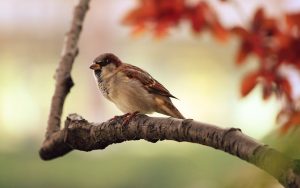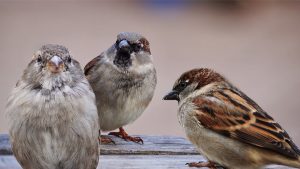I have read somewhere recently that the UK population of the house sparrow is at a worryingly low. My first port of call to check this out was the Great British Bird Watch results, the most recent being 2020.
There at the top of the most frequent garden visitor list sat the sparrow; the position they have held for some 17 years.
Was my reading incorrect, are sparrows in decline? I need to dig deeper.
The Great British Bird Watch is entering its fourth decade of providing vital information about our feathered friends. Since the first survey, the house sparrow population has plummeted by around 50. Their number seems to be showing slow signs of recovery in the last 2 or 3 years, it still raises concerns.

Table of Contents
Why are sparrows in decline
There are multiple possible reasons for the reduced number of sparrows in not only the UK but globally. Sadly, some of the causes are man-made and due to advances in technology.
Mobile phone towers
There are many cases for and against the potential risk mobile phone towers have on the avian population. There is no denying that the electromagnetic radiation emitted and the use of mobile phones outdoors harms airborne species.
Electric shocks target the birds’ nervous system, directly affecting their orientation and tracking fields. It also results in mutated embryos, psychological stress, and uncharacteristic aggressive behaviour.
Electromagnetism has similar adverse effects on insects; if the main food source of the sparrow is dramatically reduced, the number of sparrows will follow suit. Chicks rely heavily on invertebrate food from their parents, with none available, chicks don’t survive to fledgeling age.
Climate change
Global warming and the rise in greenhouses gases and emissions is a very real threat to the sparrow population.
Emissions and fumes from industry and vehicles cause air pollution, with high levels of toxins strong enough to poison and wipe out large numbers of birds.
Factor in extreme weather that seems to be ever more prevalent (think Beast from the East or un-British heatwaves) and it is easier to understand why sparrows are in decline.

Architectural design
Sparrows nest in nooks and crannies, overhangs, and crevices. Wood is used far-less in construction these days, and in its place is concrete. It is a more robust material, and the square designs aren’t conducive with good sparrow nesting sites.
Green spaces are being lost to social housing across the country. Lack of vegetation causes reduced habitats for insects and sparrows to feed and nest.
Changes in farming and agricultural practice
Livestock and grain are stored differently these days. It is no longer kept in open-sided, draughty old barns. In their place are purpose-built, secured buildings; defences that sparrows cannot breach to get to the seed.
Farming machinery has advanced and no longer leaves lots of crops behind for the sparrows and insects to feed on. Instead, more-efficient methods harvest the maximum amount of crop.
In some cases, excessive use of insect repellents and insecticides also reduce the available food, not only on farms but also gardens.
How to prevent the sparrow population from declining
Supplementary feeding is the best way, mealworms are the greatest alternative to their naturally sourced food. Live mealworms are always the best option where possible, particularly in breeding season when there are young to feed.
Sparrows are enticed by seed, although not as nutritious as worms, they fill empty bellies. Sunflower hearts have the best nutritional value and taste.
Kitchen scraps including fruit, sugar-free cereal, and vegetables will entice hungry sparrows back to your garden.
A safe place to nest is the next thing a sparrow looks for. Nooks and crannies in buildings or creeper plants such as ivy are good hiding places. They are usually rife with insects too, so the sparrow kills two birds with one stone; somewhere to sleep with room service!
Sparrows will use bird boxes, but as they live in colonies, they prefer sparrow flats or terraces, a tower of sparrows has a nice ring to it don’t you think?
Finally, if your garden is large enough to let a section grow wild, try it. It is a haven for insects and bugs, and wherever they are, sparrows follow.
Final thoughts
Less populated areas of Ireland, Scotland, and Wales have noted a steady increase in sparrow numbers; Central London is virtually bereft of them. It seems to point to the fact that increased urbanisation has a lot to pay for.
Although sparrows are in decline, some regions have recorded a 17% increase in recent years. Hopefully, it’s not too late and we can reverse the harm that we have caused.
